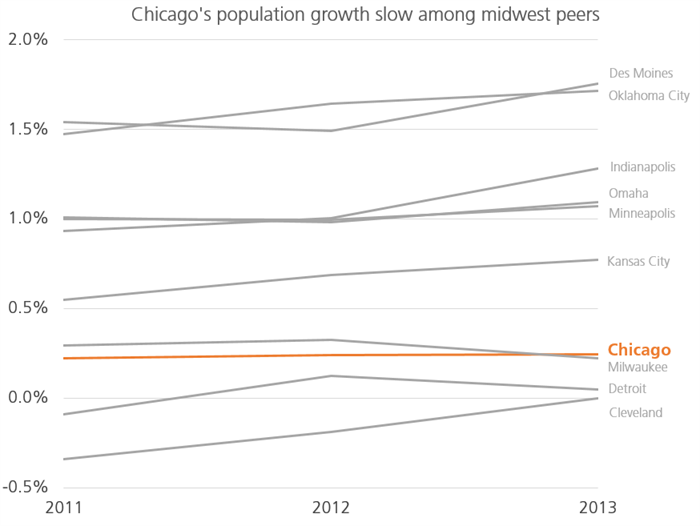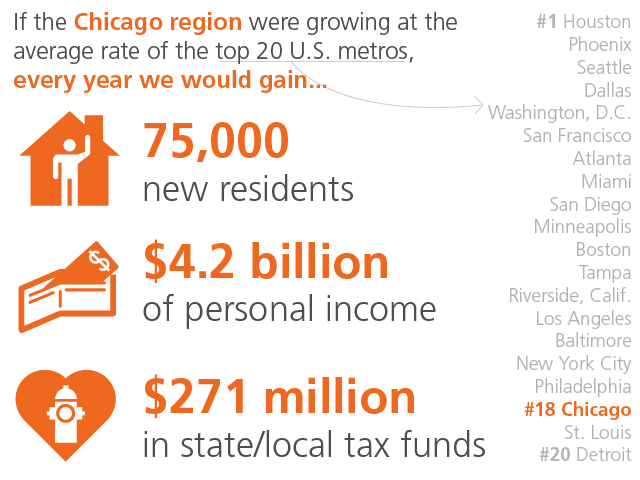
Metropolitan Planning Council
This post is the first in a series of three. Read the other two.
In 2010, the Chicago Metropolitan Agency for Planning, the official regional planning agency for northeast Illinois, forecasted that, based on current population trends, the Chicago region should grow by about 2.4 million people by 2040. That translates into about 79,000 people a year over the next 30 years. Four years into the plan, the region isn’t hitting that mark.
A growing population is important. More people means a larger, better skilled labor force that generates economic benefits as they earn income and purchase goods and services, ride transit and buy or rent homes. That in turn fuels private and public investments and creates a stronger, more vibrant region to live and work. Growth can occur naturally when the birth rate is higher than the death rate or it can happen by drawing residents from other states and countries.
Chicagoland’s growth lags other regions
According to the latest Census data, of the top 20 most populated regions in the U.S., Chicago ranked 18th in population growth. From 2010-2013 it grew by just about 20,000 people annually, about 0.22 percent a year, substantially less than most peer regions across the country. As Chart 1 and 2 below show, the Chicago region’s growth lags other big metros on the east and west coast—Philadelphia, Baltimore and Los Angeles—sunny southern regions like Phoenix, landlocked Midwestern places like Kanas City and Indianapolis and even subzero Minneapolis.

Metropolitan Planning Council analysis of U.S. Census data

Metropolitan Planning Council analysis of U.S. Census data
Looking forward, the trend continues. The Urban Institute’s Mapping America’s Future tool predicts that over the next 15 years, the Chicago region’s population will grow at much slower rates than most other metro areas across the U.S.
What if Chicagoland grew like….?
The data is clear: The Chicago region is falling behind when it comes to population growth. But does it matter? Is there a cost to us all? How would it impact state and local budgets or community development? What if we attracted proportionately the same number of people as Atlanta, Indianapolis or Washington, D.C.? We’d have hundreds of thousands more people, earning billions in income that would generate billions in consumer spending and revenues for state and local government. We’d have more people to live in the 314,000 vacant homes in the region and make progress on the region’s goal to double transit riders by 2040. We’d have more tax revenue to shore up state and local budget deficits and make sorely needed infrastructure investments.

Metropolitan Planning Council analysis of U.S. Census, U.S. Bureau of Labor Statistics and U.S. Bureau of Economic Analysis data
Yes, these are big numbers and they are hypothetical, but there are real connections when, for example, you compare population and economic growth.
For instance, as the Chart below displays, both Chicago’s population and gross regional product grew at a slower rate than peer regions across the country.

Metropolitan Planning Council analysis of U.S. Bureau of Economic Analysis data, compound annual growth rate
Further, a recent analysis by the Brookings Institution finds that the Chicago region ranks 203 among the world’s 300 largest economies in terms of annual growth of gross domestic product per person and in employment levels. That’s down from the previous ranking of 198th and lower than our U.S. peer cities such as Boston, New York, Los Angeles and Minneapolis.
This is all not to say the region lacks successes. New data from United Van Lines shows that of the 100,000 moves handled by the company last summer, Chicagoland took the top spot. A big change from the summer of 2013 when the company reported that more people were leaving than moving to the region. The region also sits at the top of several important top ten lists: WalletHub ranked Chicago second among U.S. cities for net increase in small-business jobs and Site Selection chose it as a top metros of 2013, with a high tech start up every 24 hours. On The Economist’s list of cities that will be the most economically powerful in the world by 2025, Chicago moved up from number 12 to number nine. Only two other North American cities were in the top 10: New York and Toronto.
Chicago also boasts access to talent, markets and cultural attractions—with 140,000 graduates every year, the freight hub of the nation and the number one museum in the world.
But other regions can boast similar achievements.
And it’s not enough for that success to only take place in the Chicago Loop or a few neighborhoods or suburbs.
So what do we do? It starts with a high quality of life for the entire region, both to keep existing residents from leaving and to attract more people. It’s also important that the region grow in the right direction—in existing municipalities and around transit—to reap the benefits of current infrastructure investments, reduce environmental impacts and give people the transportation options they demand.
People want to spend less time in traffic
Drivers in metropolitan Chicago spend an extra 71 hours a year stuck in traffic. Cost-effective alternatives like transit, walking or biking are often inaccessible or unsafe for many. But we're investing less in transportation than before. The Illinois motor fuel tax that funds transportation hasn't changed since 1991, when the 19 cents per gallon tax was worth about twice what it is today.
Our starvation diet has put us in the red to the tune of $1.8 billion each year. Four out of five states with similar challenges have taken action by increasing their motor fuel taxes more recently than Illinois. Just since 2012, Maryland, Massachusetts, New Hampshire, Pennsylvania, Rhode Island, Vermont, Virginia and Wyoming have all updated their fuel taxes to raise revenue and invest in the maintenance and improvement of their transportation networks.
MPC is among many organizations supporting Accelerate Illinois—a campaign that brings together citizens, organizations and businesses to share one message for Illinois lawmakers: We want transportation to be a priority in 2015. You can support the campaign for a better quality of life by joining us today.
People want more and better access to transit
The Chicago region’s transit system is disconnected from a large portion ofthe population and jobs. As of 2010, a Metropolitan Planning Council analysis of Census data shows that only 22 percent of the regional population live within a half-mile of stations on a Chicago Transit Authority El line, Metra rail line or the future Ashland Avenue Bus Rapid Transit corridor. Just 32 percent of the region’s jobs are located within half a mile of a Chicago Transit Authority or Metra rail stop. That leaves more than two-thirds of the region’s employees without easy access to a fast or efficient transit line. Compare that to San Francisco where 41 percent of jobs are within a half-mile of rapid transit, or 53 percent in New York.
Municipalities must focus development near transit. MPC is working to revise local land use policies to orient them toward increased density in areas near transit, extend the Transit-Oriented Development Ordinance passed by the City of Chicago in 2013 and develop financing tools to encourage transit-oriented developments accessible to people with a variety of incomes.
The region must also employ innovative financing techniques to fund better access to transit. Atlanta, Denver, New York City, Washington, D.C. and San Francisco all use innovative financing mechanisms like value capture to reap the benefits of increases in private land values generated by public transportation investments. MPC supports creating transit facility improvement areas to enable the Chicago region to use similar financing on sorely needed transit projects such as the Chicago Transit Authority Red and Purple Modernization and Red Line South Extension and redevelopment and added capacity at Chicago Union Station, which serves more riders a day than Midway Airport and is at capacity.
People want opportunities
Chicago’s inequality measure is the same as El Salvador, a country struggling with social instability, concentrated wealth, violence challenges and low skill levels. As my colleague Breann Gala points out, the proportion of families living in poor neighborhoods in the region (where median income is less than two-thirds of the metropolitan area median income, which was $75,475 according to the 2007-2011 American Community Survey) or affluent neighborhoods (where the median income is more than one-and-a-half times the metropolitan area median income) has increased steadily since 1970.
The Equality of Opportunity Project at Harvard University ranks Chicago in the bottom third in the ability of children from low-income families to make economic gains in a region. The study cites that “Areas with greater mobility tend to have five characteristics: less segregation, less income inequality, better schools, greater social capital, and more stable families.”
If the Chicago region wants to grow, it must work to improve opportunities for all people. Initiatives such as the Regional Housing Initiative and Voucher Pilot that reduce housing cost burden and expand transit access, and others that build municipal capacity to address the suburbanization of poverty and housing market instabilities, give people a chance at moving up economic and social ladders. And people stay in places where they see opportunity, instead of looking elsewhere for a chance at success.
As I’ve written before, Chicago isn’t constricted by these trends; we can chart a new course. Mapping America’s Future shows that even with continuation of births and deaths along historical trends, if instead we keep more people in the region and experience low out-migration, it would result in almost a 15 percent jump in population over the next 15 years: 1.25 million more people, or over 600,000 more than if we keep on pace with historical migration trends. That translates into real economics—more people means more tax revenues, transit riders, home sales, construction jobs, purchases at local businesses—a better economy and a stronger region. More tax revenues for shoring up local government deficits and making the infrastructure and community development investments that draw people to a place—and keep them.
Read the other two posts in the series: